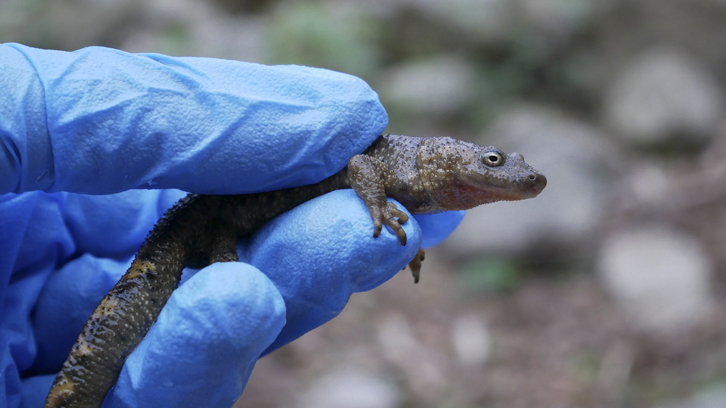Evaluation of passive integrated transponder tags for marking urodeles

A study involving researchers from the WildCoM research group of the Department of Animal Medicine and Surgery of the UAB, and the CReSA, has analyzed the tagging with integrated passive transponders in urodeles by reviewing the existing literature and designing a new implantation method. The results of the research show the need to improve and standardize implantation protocols according to the different species.
Amphibians are currently the most threatened vertebrates on Earth, with over 41 % of species facing extinction. Within amphibian orders, urodeles (salamanders and newts) are facing greater conservation challenges, reaching 400 out of 701 species under threatened categories. In order to effectively manage and conserve amphibian diversity, our ability to monitor population dynamics and the impact of specific threats is crucial. Capture-mark-recapture (CMR) studies are key tools for population ecology, providing estimates of survival, movement and population trends. Relevant aspects of disease ecology and the impact of disease on free-living populations can also be investigated through CMR data.
The use of passive integrated transponder (PIT) tags in urodeles has become popular for individual marking in population and disease ecology studies. Passive Integrated Transponder (PIT) tags are glass-encapsulated microchips that provide a unique alphanumeric code, offering permanent and unambiguous identification. Tagging can be performed via injection or by surgical implantation either under the skin, into the muscle or the celomic cavity. Despite being a relatively simple procedure, tagging can potentially affect the behavior and survival of marked individuals. Personnel expertise as well as validation of tagging protocols are highly recommended to ensure animal welfare and tag retention. Mark loss or mark-induced mortality can introduce biases and decrease precision in parameter estimates, leading to ineffective population management strategies.
In this study we aimed to 1) analyze the existing literature on the use of PIT tags in urodeles; 2) determine whether species characteristics and PIT tagging methods influenced PIT tag rejection across studies; and 3) experimentally assess the adequacy of a subcutaneous PIT tagging method without anesthesia in three European urodele species. We systematically and quantitatively reviewed a database of literature related to the use of PIT tags in urodeles, classified and examined urodele species details, study design, PIT tagging methods, and outcomes across studies.
Among the 51 scientific papers that fit our criteria, the most striking finding was the lack of reporting and standardization of the PIT tagging procedures. The majority of studies presented incomplete information on factors that could strongly influence the probability of PIT tag rejection as well as impact individual welfare (e.g., PIT tag size, its anatomical placement in the animal, use of anesthesia, sterility or skin closure methods). We could not identify significant predictors of PIT tag loss, suggesting that the effectivity of PIT tags may be highly specific to the species and method used. Our PIT tagging method proved reliable in Salamandra Salamandra and Pleurodeles waltl, whereas it did not seem a suitable technique for Calotriton asper (66.6% lost their PIT tags).
Overall, we recommend a greater emphasis on reporting implantation methods, ensuring animal welfare and performing species and protocol-specific laboratory trials before using PIT tags in urodeles in the field. Critically analyzing PIT tagging methods as well as testing their use in different species is essential to ensure the validity of future research studies and conservation strategies in urodeles.
(1) Wildlife Conservation Medicine Research Group (WildCoM), Departament de Medicina i Cirurgia Animals. Facultat de Veterinària, Universitat Autònoma de Barcelona (UAB).
(2) Catalonia Reptiles and Amphibians Rescue Center (CRARC).
(3) Unitat Mixta d’Investigació IRTA-UAB en Sanitat Animal. Centre de Recerca en Sanitat Animal (CReSA). Universitat Autònoma de Barcelona (UAB)
References
Ribas MP, Alonso-Almorox P, Espunyes J, Martínez-Silvestre A, Cabezón O. (2022). Evaluation of passive integrated transponder tags for marking urodeles. Ecological Indicators, 145, 109690. doi: 10.1016/j.ecolind.2022.109690


